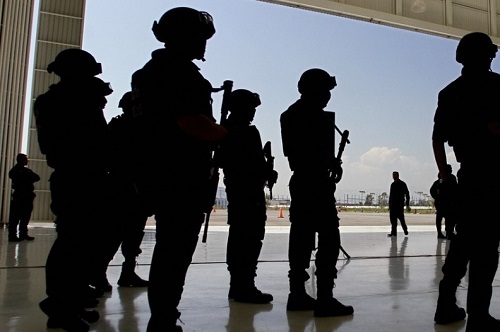AFP photo
By
Ricardo Swire
Within the past five years international border security enforcement has been modified, but organized crime syndicates promoting human trafficking continue to thrive and become more powerful. Human smuggling was originally a criminal derivative considered a “small time” family pastime. More recently United Nations data calculated the underworld business generates US$35 billion annually. Criminal heavyweights Los Zetas and Gulf Cartel in Mexico have now adopted human trafficking as a main revenue stream.
Other transnational criminal groups chose the human trafficking market because tighter border security and enforcement meant increased clients and service prices, as more sophistication and resources are needed. Powerful local organized crime groups result in spiralled corruption, social instability and additional migration. A typical scenario is Washington’s new “Zero Tolerance” of illegal immigration, promoted on the basis of lowering crime rates in America, four thousand Border Patrol agents added to the Tucson sector alone.
An internal security analysis determined the US border control policy contributed more to the reverse, rather than act as a deterrent. Deportations along the Mexico/US border provide several recruits for criminal ranks. US Border Patrol oversees a three layer security line that extends one hundred and forty miles north of Mexico’s border with Guatemala and Belize. The security system uses sensors and intelligence-gathering to counter human trafficking and drug running from Mexico, a major source of illegal immigration to America.
In the past US asylum seekers wore “ankle monitoring bracelets” and interacted with other US residents. Border security patterns highlighted the forty percent of foreign offenders who detached their monitoring devices and disappeared before attending US immigration hearings. The activity is known as “catch and release,” although US Federal immigration enforcement refers to it as “catch and run.” In 2013 US Immigration & Customs Enforcement (ICE) deported one hundred and six thousand, four hundred and twenty Guatemalans, Salvadorians and Hondurans. Fifty-nine percent of three hundred and seventy thousand deportees were criminals.
US Zero Tolerance includes cancellation of the “Temporary Protected Status” that safeguarded such El Salvador and Honduran nationals. In the underworld Mexico drug cartels aka “la mafia” control an extensive network of human traffickers, transporters, flophouses, guides, lookouts, enforcers and informants. Along the Mexican/US border illegal migrants pay cartel appointed coyotes no less than US$4,500 each to cross the Sasabe desert and enter Arizona, USA.
“Los Memos” and “Los Salazar,” two splinters of the Sinaloa Cartel, tussle for control of the migrants. ‘Zero Tolerance’ successfully breached the trust between US law enforcement and migrant communities, where organized crime syndicates and gangs blend in. Vilification can shutdown cultivated intelligence gathering channels. Witnesses, who are part of law enforcement investigations, may refuse to testify or assist. The modified US/Mexico border controls have also created a clandestine migrant hub in Altar, Mexico.
Intelligence reports described illegal asylum seekers who braved Altar’s remote desert route to enter the USA. Altar shares its border with Arizona. Mexican drug cartels’ gunmen patrol the town on motorbikes, supported by colleagues in four-by-four pickup trucks with tinted windows and no license plates. Entry to Altar, aka the “Migrant Oasis,” is totally controlled. The mafia is entrenched along the two thousand mile US/Mexico border.
Mexico’s internal security officials utilized US$2 billion from the Merida Initiative, or America’s anti-drug trafficking program, to counter local criminal entities with three security cordons. The zones are monitored with electronic security technology. One zone extends along the southern Mexican border, the second follows a line extending twenty miles away, while the third security zone stretches one hundred and forty miles from the southern Mexican territorial line. Patterns reflecting the combination of Mexico’s enforcement, plus US Zero Tolerance and Border Patrol initiatives, have whittled the illegal migrant options to desolate and perilous areas such as the Sonoran desert.
Ricardo Swire
Ricardo Swire is the Principal Consultant at R-L-H Security Consultants & Business Support Services and writes on a number of important issues.



No Comments Yet!
You can be first to comment this post!